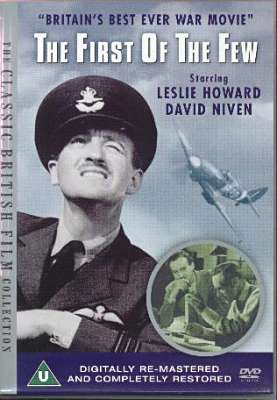This 1942 Leslie Howard production is a fictionalised
account of how R.J. Mitchell came to design the Spitfire, the plane
that won the Battle of Britain. It had the enthusiastic support of Winston
Churchill as a morale booster during the dark days of World War II.
Sir William Walton wrote the stirring music that he was later to lift
and arrange slightly to become the popular concert piece ‘Spitfire Prelude
and Fugue’.
One notices immediately how sparingly Walton’s music
is used in the film. The Prelude is the opening Title Music not too
well performed and none too clearly recorded, despite the DVD’s claims
that the audio content has been remastered. The fugue drives the montage
showing the building of the plane. A reflective, romantic variation
(featuring solo violin) of the Prelude underscores scenes between Mitchell
and his wife (Rosamund John) and the Prelude and Fugue join together
in a victorious alliance as the completed plane is wheeled out of the
workshops. Scraps of other atmospheric music are heard too.
Disappointingly there is no mention of Walton’s contribution
in the feature material that accompanies the film. [He was exempted
from military service, despite having attempted to join up, to provide
music for films deemed to be ‘of national importance’. During 1941 and
1942 he wrote music for: Next of Kin (a documentary about bad
security – "careless talk costs lives"), Went the day Well
and The Foreman Went to France as well as The First of the
Few ].
An Introduction is included by Mitchell’s son, Dr Gordon
Mitchell (not R.J. Mitchell as claimed on the DVD box) who comments
that the character, Crisp, played by David Niven, is a composite of
all the test pilots who worked on Mitchell’s designs including the sea-planes
that won so many Schneider Trophy races in the 1920s and early 1930s.
He also corrects the alleged facts about Mitchell’s death which in reality
was of cancer that had been diagnosed many years earlier, although there
is no denying that the urgency of developing the plane sapped his strength.
There is also a commentary by Jeffrey Quill, one of Mitchell’s test
pilots, who denigrates the notion that the spitfire’s design was influenced
by the flight of seagulls as the opening romantic scenes suggest.
At Odyssey’s reasonable price this is an irresistible
piece of wartime nostalgia well-acted and, of course, there is Walton’s
stirring music.
Ian Lace


